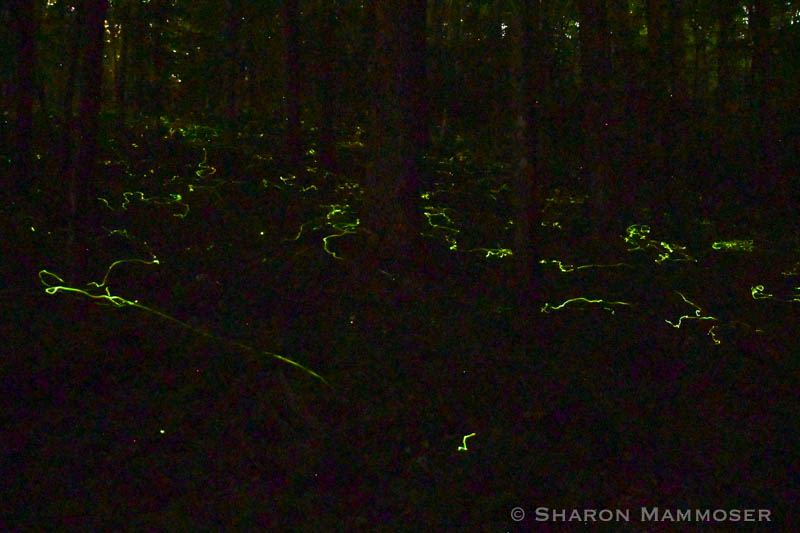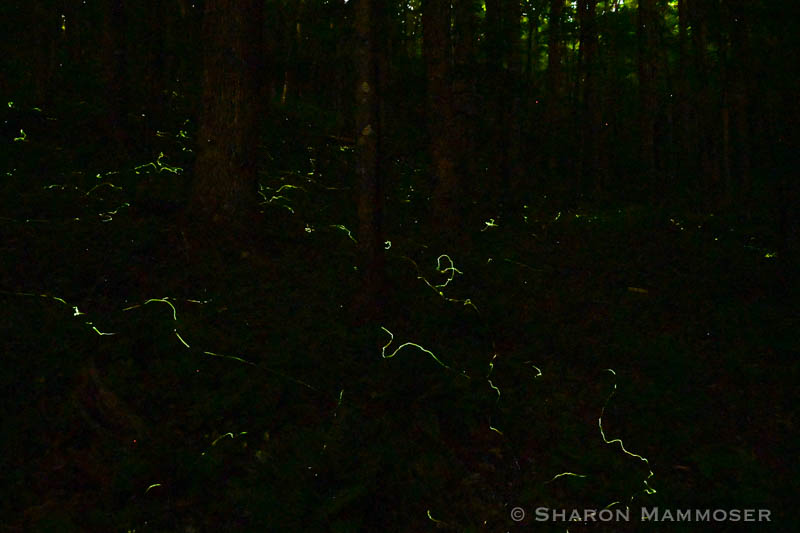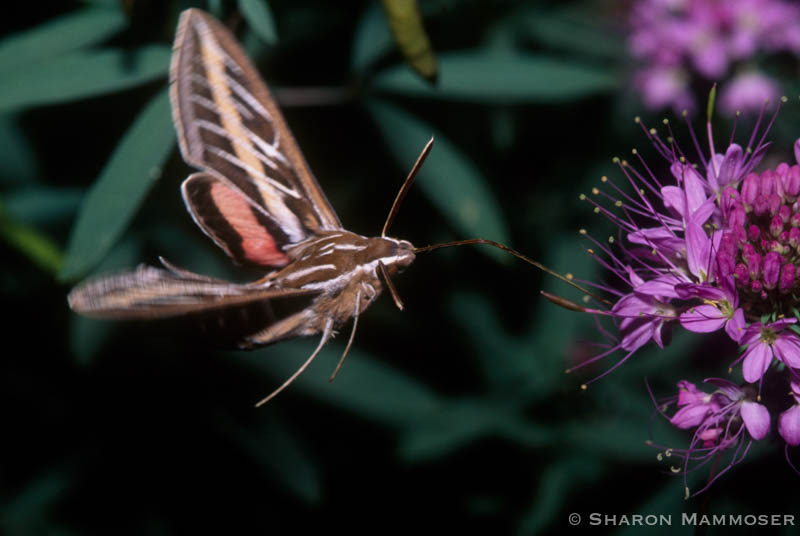I’ll be the first to say I’m definitely a morning bird, not a night owl. By the time 10:00pm rolls around it’s highly likely I’ll be in bed, snuggled tightly between my cat, dog and husband. How about you–Are you a night owl or a morning bird?

In May and the beginning of June, for just about the entire three weeks that the blue ghost firefly was active I changed my bedtime in order to watch their magic show each evening, which usually got started around 9:45 and lasted until just before midnight. Unlike some fireflies that become active at dusk, blue ghosts wait until it is dark before lighting up the forest with their eerie light trails. Many nights I stood alone in the darkness, silently surrounded by moving trails of light that never failed to make me feel awe and fascination. How can such a tiny insect make such a bright light? How do they ever find each other when the females are only the size of a grain of rice and she can’t even fly? What’s it like for other animals like bears or deer to come upon a hillside dancing with the light of blue ghosts? I had many such questions as I watched them move about the forest each night, and each night I was guaranteed to go to bed with my soul recharged. When I closed my eyes it was the lights of all of those tiny insects that bid me goodnight and made me feel like the richest woman on Earth. Did you know blue ghost fireflies are found no where else in the WORLD other than southern Appalachia?

A few weeks went by and I was back to my normal bedtime routine. Until one day recently when my friend Kim invited me over for another nighttime magic show. A self-professed nature geek like myself, Kim grows a wide variety of flowers (She is the owner of a farm called Milkweed Meadows) including a night-blooming flower called the Tina James Magic Evening Primrose, Oenothera glazioviana. Have you heard of it? Seen it in a garden near you? Perhaps you too have been lucky enough to be invited to an evening primrose party? If so you are definitely fortunate as this plant is unlike any other I’ve ever seen.
Kim has three big bunches of magic primrose so just before dark we all headed down to gather beside a bunch of the nondescript plants, which were several feet tall, sandwiched between the straight stalks of red bee balm and purple liatris. We could see pale yellow petals peeking out of the edges of a few of them, their petals tightly coiled by pinkish green sepals.


The magic of this plant is in the quickness at which the flowers bloom, literally bursting open in mere seconds as the last light of day fades to darkness. They don’t make a sound as they do this, but it’s easy to imagine a sharp POP, as the yellow petals unfurl. We tried to predict which ones would open first, each of us stating our guesses. And we watched. And then! Suddenly! The wrapping from the yellow petals let go and the lovely yellow flower opened. In less than 20 seconds it was fully open, its light color and sweet scent like a welcome mat for moths. It really is Mother Nature’s silent fireworks display! One of Kim’s flower patches had more than
A writer from the Baltimore Sun named Naincy Taylor Robson described it perfectly, saying, “Suddenly, in one fluid motion as though drawn by an unseen hand, the sepals — the green outer covering of the flower — peeled back. Then the blossom itself, furled like a fairy umbrella, swelled. One petal flipped away from the others, and then, before my eyes, the flower spread wide. It was like seeing time-lapse photography in person. Magic!”
We thought the show ended with all of the yellow blossoms fully open but as we stood there talking the blooms and the possibility of moths, we were treated to a second show–this one featuring a long-tongued moth that visits the flowers to get their sweet nectar. We saw a couple of moths, including one called a white-lined sphinx moth (Hyles lineata.) Sphinx moths are famous for having especially long proboscises. (There is one that lives in Madagascar that has a proboscis longer than 12 inches!) but there are many others who will readily visit magic primrose and other night-blooming flowers. In order to access the sweet nectar, the moth must maneuver its long tongue (proboscis) into the center of the flower and down the long tube to the nectary. In this flower that distance is several inches long.

We were treated to several moths in our short time in front of the flowers but I was only were able to photograph and positively identify one species. So of course this means I will have to try again. It’s like getting mud-covered to take a picture of a dragonfly nymph emerging as a winged adult–I’m in! This sounds like my kind of challenge, a fact that obviously equals more late nights. The things we do for science! And photography.
As I left town and traveled west to Colorado, Kim continued to visit the primrose patch each night, discovering all kinds of cool things in my absence. She photographed several other moth species and even watched one pink and yellow moth, aptly called a primrose moth, laying her eggs on a flower bud!
We also learned that this flower has what are called viscin threads. This is different than the pollen in other flowers, as it sticks to the insects in long, wispy, cobweb-like strands. When we first saw a moth with these threads on its legs we thought the moth had really long legs, but wondered why they were so dangly and limp. The viscin threads explained it! You might see it in the video if you’re looking closely and especially, if you’re watching on a bigger display than a cell phone.
You can check out some of the night action here in this video compilation that I created. Special thanks to Kim for inviting me over for her multiple Primrose parties AND for for generously sharing her videos and photos with me to use for this post. Not to mention that I now have a few Magic Primrose plants of my own, courtesy of Kim. I’m hoping to have a Primrose Party of my own come next July–If you’re a blog subscriber and live in western NC, you might be invited!
If you want this in your garden, you can buy seeds online, searching for Tina James Magic Primrose, (Oenothera glazioviana.) Here are a couple of possibilities.
Select Seeds
180 Stickney Hill Road Union, CT 06076 www.SouthernExposure.com
Southern Exposure Seed Exchange
P.O.Box 460
Mineral, VA 23117 www.selectseeds.com
Or you could do like the old timers and drive around your neighborhood in the beginning of July, looking for the telltale circle of chairs around some green nondescript garden plants. Introduce yourself, make a new friend and maybe even get some of the seeds from this special plant. This is the way it was done years ago and I suspect there are some old timers out there who put their chairs out and gather at dusk in early summer.
In addition, here are some public gardens that grow this special plant. This list comes from the end of the self-published children’s book by Tina James called A Light in the Night: The Story of the Magic Primrose by Tina James.
American Visionary Arts Museum Baltimore Inner Harbor
800 Key Highway
Baltimore, MD 21230-3940 410-244-1900
4-H Children’s Garden Michigan State University East Lansing, MI 48823-5399 517-353-6692
United States Botanic Garden 245 First Street, S.W. Washington, D.C. 20024 202-225-8333
Have you seen this unique flower? Been to your own primrose party? Watched some interesting moths? I would love to hear from you! Please take a minute to get in touch using the comment box at the end of this post. Hope to hear from you soon! Thanks for reading.


Amazing video!!!!
Thanks Renee, I’m glad you enjoyed it. Hope you get to see them in person next summer.
You’re welcome, Rose. Glad you enjoyed it. Do you have a moon garden in your yard? My moon flower isn’t blooming yet but I’m looking forward to seeing it one of these days.
You & Kim had a super wonderful, exciting time together!! I have a new respect for moths!! The primrose opens like a moonflower, right in front of your eyes! It’s just magic! Thanks so much for sharing!!